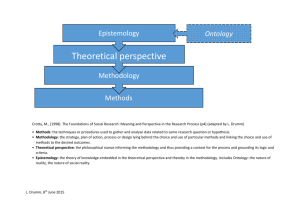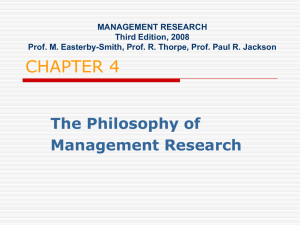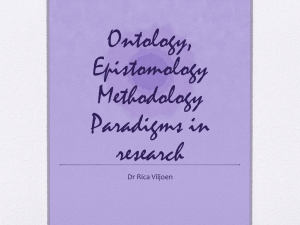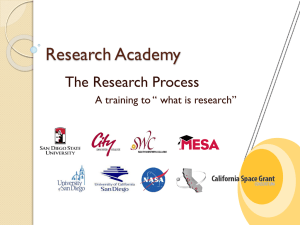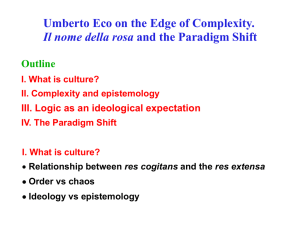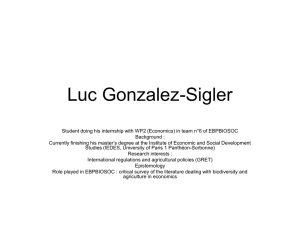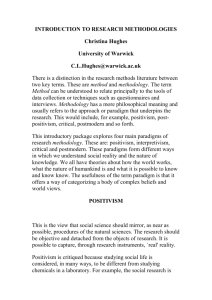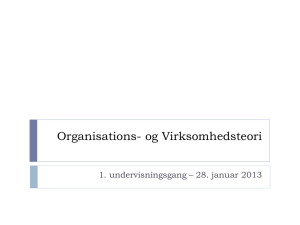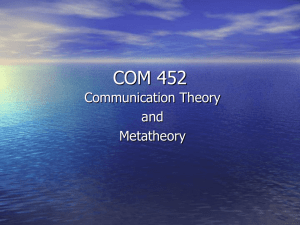Research Perspectives Overview
advertisement
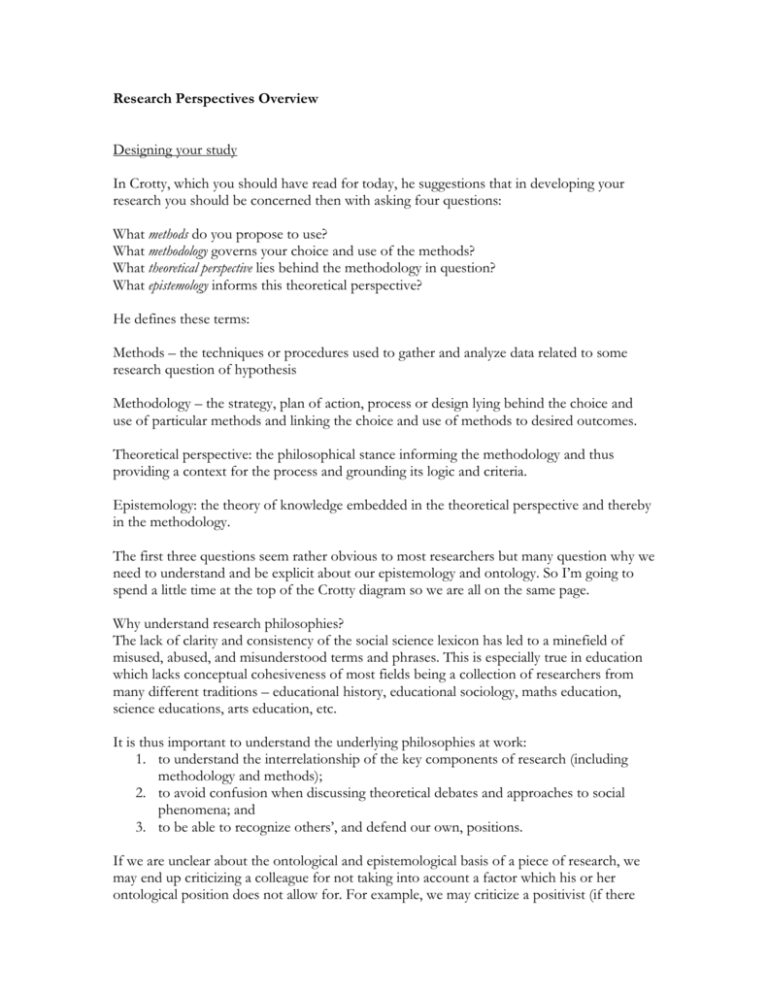
Research Perspectives Overview Designing your study In Crotty, which you should have read for today, he suggestions that in developing your research you should be concerned then with asking four questions: What methods do you propose to use? What methodology governs your choice and use of the methods? What theoretical perspective lies behind the methodology in question? What epistemology informs this theoretical perspective? He defines these terms: Methods – the techniques or procedures used to gather and analyze data related to some research question of hypothesis Methodology – the strategy, plan of action, process or design lying behind the choice and use of particular methods and linking the choice and use of methods to desired outcomes. Theoretical perspective: the philosophical stance informing the methodology and thus providing a context for the process and grounding its logic and criteria. Epistemology: the theory of knowledge embedded in the theoretical perspective and thereby in the methodology. The first three questions seem rather obvious to most researchers but many question why we need to understand and be explicit about our epistemology and ontology. So I’m going to spend a little time at the top of the Crotty diagram so we are all on the same page. Why understand research philosophies? The lack of clarity and consistency of the social science lexicon has led to a minefield of misused, abused, and misunderstood terms and phrases. This is especially true in education which lacks conceptual cohesiveness of most fields being a collection of researchers from many different traditions – educational history, educational sociology, maths education, science educations, arts education, etc. It is thus important to understand the underlying philosophies at work: 1. to understand the interrelationship of the key components of research (including methodology and methods); 2. to avoid confusion when discussing theoretical debates and approaches to social phenomena; and 3. to be able to recognize others’, and defend our own, positions. If we are unclear about the ontological and epistemological basis of a piece of research, we may end up criticizing a colleague for not taking into account a factor which his or her ontological position does not allow for. For example, we may criticize a positivist (if there still is such a thing) for not taking into account the hidden structures at work in society when a positivist ontology and epistemology do not allow for unseen structures. Ontology and Epistemology: the Philosophical Building Blocks Ontology You may see or hear the word ontology mentioned but it isn’t included in Crotty’s schema. Blaikie (2000, pg 8) has described ontology as ‘claims and assumptions that are made about the nature of social reality, claims about what exists, what it looks like, what units make it up and how these units interact with each other. In short, ontological assumptions are concerned with what we believe constitutes social reality.’ An individual’s ontological position is their answer to the question: what is the nature of social and political reality to be investigated? In the Crotty framework it would sit alongside epistemology and also inform our theoretical perspective. We can not critique a researchers’ ontology – it is a personal assumption which is impossible to refute empirically – there are no wrong or right ontologies. Epistemology Blaikie (2000, pg 8) describes epistemology as ‘the possible ways of gaining knowledge of social reality, whatever it is understood to be. In short, claims about how what is assumed to exist can be known’. Many researchers confuse ontology, epistemology and theoretical perspective. Because of this confusion Crotty has left ontology out of his framework. But the assumptions underlying every piece of research are both ontological and epistemological. In his lovely children’s book, Fish is Fish, Leo Lionni tells a story of a friendship between a tadpole and a minnow. They love their life in the pond as they both grow up. Once the tadpole becomes a frog, he follows his urge to explore the world outside of the pond. When he returns, he regales the fish with tales of brightly colored birds, cows with pink bags of milk, and people who wear clothes. The illustrations in the book show that while the frog is talking, thought bubbles of the fish show fish with brightly colored wings and tails flying through the sky; fish with ears, horns and pink bags of milk; and fish wearing clothes and walking upright on their tales. The point being that what the fish ‘sees’ is a product of the nature of his reality and the ways he has come to know things. Different views of the world and different ways of gathering knowledge exist. Crotty suggests that we have three epistemological positions: Objectivism where knowledge exists whether we are conscious of it or not. It is foundationalist and absolute. Researchers with this position try to find causes, effects, and explanations. They try to predict events and test theories and hypotheses. And this stands in opposition to the other two positions which seek to understand and describe rather than explain. Subjectivism may be defined as the view that comprehending human behavior consists solely in reconstructing the self-understandings of those engaged in performing them. To comprehend others is to understand their meaning of what they do and to understand this meaning is to understand them in their own terms. Constructivism believes that social phenomena develop in particular social contexts. The concepts or practices in a particular context may seem obvious and natural but are actually artifacts of that context. Individuals and groups participate in the creation of their perceived social reality and this reality is ever evolving as social interactions occur. Activity 1: Language Used in Abstracts We can begin to distinguish between epistemologies by focusing on the language researchers use to describe their studies. You have 4 abstracts. Read the abstracts and underline words which you think may illustrate the philosophical position of the researchers. I don’t expect you to be able to identify which epistemological position they are taking (this will come as you get more lectures on philosophies and paradigms) but I do want you to notice the differences in the words used to describe research which provide clues to these underlying assumptions. So back to our design framework: epistemology theoretical perspective methodology methods Hay (2002, pg 64) gives us another version of this same idea: Ontology What’s out there to know? Epistemology What and how can we know about it? Methodology How can we go about acquiring knowledge? Adapted from Hay, 2002, pg. 64 Methods What procedures can we use to acquire it? Sources Which data can we collect? The four elements inform one another. There are many choices in each category but this table provides the major examples: Epistemology Objectivism Constructionism Subjectivism (and their variants) Theoretical Perspective Positivism Post-positivism Interpretivism Symbolic interactionsim Phenomenology Hermeneutics Pragmatisim Participatory Critical inquiry Feminism Postmodernism (etc.) Methodology Experimental research Survey research Ethnography Phenomenological research Grounded theory Heuristic inquiry Action research Discourse analysis Feminist standpoint research Case Study (etc.) Methods Sampling Measurement and scaling Questionnaire Observation Participant Nonparticipant Interview Focus group Life history Narrative Visual ethnographic methods Statistical analysis Data reduction Theme identification Comparative analysis Cognitive mapping Interpretative methods Document analysis Content analysis Conversation analysis (etc.) We also in the Crotty diagram have a number of theoretical perspectives which form a continuum of epistemological positions. Post-Positivism Positivism Objectivity Pragmatism Interpretivism Participatory Postmodern Subjectivity Another way to think about how these theroretical perspectives relate is to think of them historically. As you have sessions on each of these perspectives you’ll see how perspectives emerged along an historical continuum as well. Theoretical Perspective History Interpretivism Postmodern Post-Positivism Positivism Participatory Pragmatism We’ll briefly focus on the assumptions of 4 now: Assumptions of Post-positivism: 1. Absolute truth can never be found – we can’t prove something we can only disprove something 2. Research is a process of making claims and then refining or abandoning some of them for other claims more strongly warranted – we test a theory. 3. Data, evidence and rational considerations shape knowledge. 4. Research seeks to develop relevant true statements that can serve to explain the situation that is of concern or that describes the causal relationship of interest. 5. Researchers must examine their methods and conclusions and identify bias. Positivism is not: Many times, critics of positivism confuse it with other concepts so let us also be clear about what positivism is not: 1. Sometimes critics target positivism when they really mean behaviorism. – they have a lot in common. Behaviorism favors the operationalsim of concepts so behaviorists are positivists but not all positivists are behavioralists since positivists believe that you can do research on things that are not observable as long as they are quantifiable and measurable. 2. Positivism is sometimes mistaken for empiricism. Empiricism assumes that our concepts and our knowledge are wholly or partly based on experience through the senses or introspection. Positivism then is a type of empiricism but not all varieties of empiricism are positivistic. Assumptions of Interpretivism: 1. Meanings are constructed by humans as they engage with the world they are interpreting. 2. Huamsn make sense of the world based on their historical and social perspective. They seek to understand the context and then make an interpretation of what they find which is shaped by their own experiences and backgrounds. 3. The basic generation of meaning is always social. Assumptions of Participatory: 1. Participatory research is recursive ad dialectical and is focused on bring about change in practices. 2. It is focused on helping individuals free themselves from constraints and often begins with a stance about the problems in society. 3. It is emancipatory – it aims to create a debate so that change will occur. 4. It is inquiry completed with others rather than on or to others. Assumptions of Pragmatism: 1. Is not committed to any one system of philosophy or reality. 2. Individual researchers have freedom of choice to select procedures that best meet their needs. 3. Pragmatists do not see the world as an absolute unity. 4. Truth is what works at the time. 5. Look to the “what” and “how” to research based on its intended consequences. 6. Research always occurs in social, historical, political, and other contexts. 7. We need to stop asking questions about reality and the laws of nature and start solving problems. Remember – mixed method/pragmatism would have a string without an epistemology and may also be lacking a theoretical perspective. In using our framework to design a study, the only limitations really exist between matching epistemology and theoretical perspective. Positivism is always paired with objectivism. Phenomenology is always constructionism. And postmodern could never be objectivist. Beyond these, anything in any column can be paired with anything else – any of the theoretical perspectives can be paired with the methodologies and any of the methodologies could be paired with any of the methods. While there are typical pairings, they are not mandatory. Looking at the most famous work on the concept of ‘social capital’ illustrates how the epistemology and ontology of the researcher drives the choices they make for the study. Robert Putnam Objectivist Positivist Survey Research Statistical Analysis In Robert Putnam’s work on social capital in Italy, he believed that ideas like trust in government were psychological concepts that could be measured at the individual level. Then these individual measures could be aggregated to decide whether a community had sufficient levels of social capital for democratic governance to occur. James Coleman’s idea of social capital is based on a very different string: Constructionist Interpretive Case Study Interviews James Coleman believe that social capital should be understood as context dependent and as a resource created by actors working together – social capital doesn’t just exist, it is created through interaction between actors and contexts in which they act. In this way social capital moves from being an independent variable (in Putnams work it is required to be present for democracy to occur) to a dependent variable (in Coleman’s work it is the result of social interactions and context). Thus, these researchers are studying the same idea but their own epistemological and ontological assumptions lead to different methodologies, methods, and ultimately different conceptions of the concept itself. Thus far, we’ve been talking about having our epistemology and theoretical perspective lead us to methodology and methods. In the real world of research, we start with our methodology and methods and then go back to identify the theoretical perspective and epistemology. We don’t start research be saying – I’m a constructivist so I should study X. We begin with a problem, a real-life issue we want to research. We then identify the best strategy for understanding our problem (the methodology and methods). Later, because we want to provide a justification for our choices we will lay out the research processes we engaged in and we will defend those processes. In laying out our processes and defending them we identify for the reader our assumptions about the theories we use and how we know what we know. Most of the time though, even the questions you are interested in asking say something about how you view the world. Activity 2 Use the blank Crotty diagram to identify the chain that seems to underlie your own research interests. We’ll share examples when we are finished.
